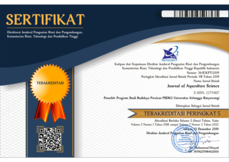Guide For Authors
The Journal of Aquaculture Science (JoAS) is a medium for exchanging information and scientific work in the field of Aquaculture published by the Aquaculture Study Program, PSDKU Banyuwangi at Airlangga University. Published scientific works include; fish culture, reproduction and disease techniques, aquaculture environment, and biotechnology. The Journal of Aquaculture Science accepts original articles, article reviews, short communications, and Technical reports. The article must be written in English. therefore the author shall ensure that the manuscript is collected in accordance with English writing principles and there is no error in wording, the script should be typed using Microsoft Word program. The author who will submit the article must fill out the registration form along with their chosen manuscript. The author also has to include their information on the manuscript including name of the author, address, phone number, fax and E-mail. Two files need to be uploaded via OJS including the manuscript and author information which can be found in this link. The author has responsibility for the originality of their research and the manuscript content which will be submitted. Therefore there is a publishing process for the manuscript, such as :
- The process of filling out the registration form and manuscript collection
- The process of evaluating the manuscript by the appointed reviewer
- Manuscript revision process
- Editing that has been declared Accepted
- Submitting the results of the manuscript edits to the author for proofread
- Request an Assignment of Copyright from the author
- Publishing scientific articles
Writing Format
General Requirements
- Article is typed on A4 size paper with two column format, 2 cm margin on each side, typed with 1.15 spaces using Times New Roman font 12 pt size, article that has been made must not more than 20 pages.
- Specify the number pages at the bottom right starting with page 1 in the title section.
- The use of scientific names typed using italic text. Writing the full scientific name is done when it is first mentioned in text, figures and tables.
- Scientific unit, abbreviation, and the symbols used are those that are commonly used and follow scientific principles.
- The writing of numbers is done in letters unless followed by a unit of measurement (example: hundreds of fish, 2 kg)
- Time writing format uses 24 hours (example: 06.30), date writing format start with day, date, month and year (example: 07 January 2016).
- Every reference that has been cited inside the manuscript must be included in bibliography. Reference citation on the manuscript use the following rules :
- Single author, example : (Andi, 2015) or Andi (2015).
- Two authors, example : (Andi and Faisal, 2015) or Andi and Faisal (2015).
- Three authors or more, example : (Andi et al., 2015) or Andi et al. (2015).
- Citations of manuscripts that have been received, example : (Andi, In Press) or Andi (In Press).
- Using citation from unpublish reference is prohibited.
Script Writing
- Manuscript writing format consist of Title, Writers name, institution name and address, abstract, introduction, material and methods, results, discussion, conculsions, acknowledgements, and references written in justify. All the text written in uppercase letter and bold.
- In sub-section it is written in capital letters at the beginning of the sentence, Bold and the position of it on the left of the page (allignment left/justify).
- Title : Short, informative and clear, written in English language, title written in Times New Roman 14 pt.
- Writers name : Full name, using Times New Roman 11 pt.
- Instutions Name and address : written in full with number and street name, city/districts, postal code, province, telephone number, and fax (if available). The authors is given a number (1, 2, etc) based on the origin of the faculty/department and for author correspondence is given a mark (*) and written the email, using times new roman font 10pt
- Abstract : written in short (200-300 words), abstract must be informative and described the research purposes briefly, spesific metode, the main results, and the main conclusion. Abstracts are often presented separately from articles, so it must be able to stand on its own (printed separately from full articles), Abstract written in English and Indonesia language, using times new roman 10pt
- Keywords : maximum of five words, including scientific names and local (if there are), the research topic and specific metode; sorted from A to Z; written in English language.
- Abbreviation (if available) : every important abbreviation must mentioned their continuation at the first mention and must consintent.
- Introduction : around 400 to 600 words, covers the research purposes and provide an adequate background, avoid detailed literature surveys or summary results. Show the research objectives at last paragraph. Bibliography in the manuscript is written in the "name and year" system; and arranged from newest to oldest order. Then from A to Z. In citing an article written by two authors, both should be mentioned, however, for three and more authors, only the last (surname) of the first author was mentioned, followed by et al. (italic), for example : Saharjo and Nurhayati (2006) or (Boonkerd 2003a, b, c; Sugiyarto 2004; El-Bana and Nijs 2005; Balagadde et al., 2008; Webb et al., 2008). Graded quotes as indicated by the word cit. or in should be avoided.
- Material and methods : should emphasize procedures / work methods and data analysis. For field studies, it is preferable to include research locations. The existence of certain equipment which is important is sufficient to mention in terms of operation.
- Results and discussion : written as a series, however, for manuscripts with a long discussion can be divided into several subtitles. The results should clearly and concisely answer the questions why and how the results occurred, not just express the results in words. The discussion must refer to the libraries of previous research, not only the author's opinion and written in scientific language in accordance with the rules of writing scientific papers.
- Conclusions : At the end of the discussion there needs to be a closing sentence.
- Acknowledgements : (If any) is presented briefly; all sources of research funding need to be identified, and any potential conflicts of interest identified. The mention of the person's name needs the full name. Attachments (if any) must be included in Results and Discussion.
- References : As much as 80% of bibliography must come from scientific journals published in the last 10 years, except for taxonomic studies. Bibliography writing format is as follows:
- Journal (APA Style) :Verschuere, L., Rombaut, G., Sorgeloos, P., & Verstraete, W. (2000). Probiotic bacteria as biological control agents in aquaculture. Microbiology and molecular biology reviews, 64(4), 655-671.
- Article DOI : Jin, E.S. & Melis, A. Biotechnol. Bioprocess Eng. (2003) 8: 331. https://doi.org/10.1007/BF02949276.
- Book : Rai MK, Carpinella C. 2006. Naturally Occurring Bioactive Compounds. Elsevier, Amsterdam.
- Proceedings : Alikodra HS. 2000. Biodiversity for development of local autonomous government. In: Setyawan AD, Sutarno (eds). Toward Mount Lawu National Park; Proceeding of National Seminary and Workshop on Biodiversity Conservation to Protect and Save Germplasm in Java Island. Sebelas Maret University, Surakarta, 17-20 July 2000.
- Thesis, Dissertations : Johari HS. 2009. Analisis Pencemaran Logam Berat Cu, Cd, dan Pb di Perairan Kabupaten Administrasi Kepulauan Seribu Provinsi Jakarta [tesis]. Bogor (ID): Institut Pertanian Bogor.
- Online Document : Balagadde FK, Song H, Ozaki J, Collins CH, Barnet M, Arnold FH, Quake SR, You L. 2008. A synthetic Escherichia coli predator-prey ecosystem. Mol Syst Biol 4: 187. www.molecularsystemsbiology.com [21 April 2015].
Instructions For Authors
Authors who wish to enter a script must pay attention to the points below. If the manuscript does not match the stated requirements, there is a possibility that the manuscript will be returned.
- The submission has not been previously published, or is under consideration for another journal (or an explanation has not been provided in comments to the editor).
- Manuscript files in Open Office, Microsoft Word, RTF, or WordPerfect document file formats.
- When available, URLs for reference are provided.
- single space text; font 12; italic; not underlined (except URL address); and all illustrations, figures and tables placed in the text at their proper point, not at the end.
- Text that complies with the requirements regarding libraries and stylistics is outlined in the Scriptwriters Guide, which will be found on the About Us page.
- The review process is carried out by double blind review, in which the identities of the author and guest editor are hidden. However, in a case to speed up the identification process, the two of them can be opened with the consent of both parties.
- Authors will generally be notified of acceptance, rejection, or the need to revise within 2-3 weeks.
- Manuscripts are rejected, if the content does not match the scope of publication, does not meet ethical standards (namely: false authorship, plagiarism, duplication of publication, data manipulation and manipulation of citations), does not meet the required quality, is written not in accordance with the format, has a grammar that is complicated, or ignore correspondence within three weeks.



















